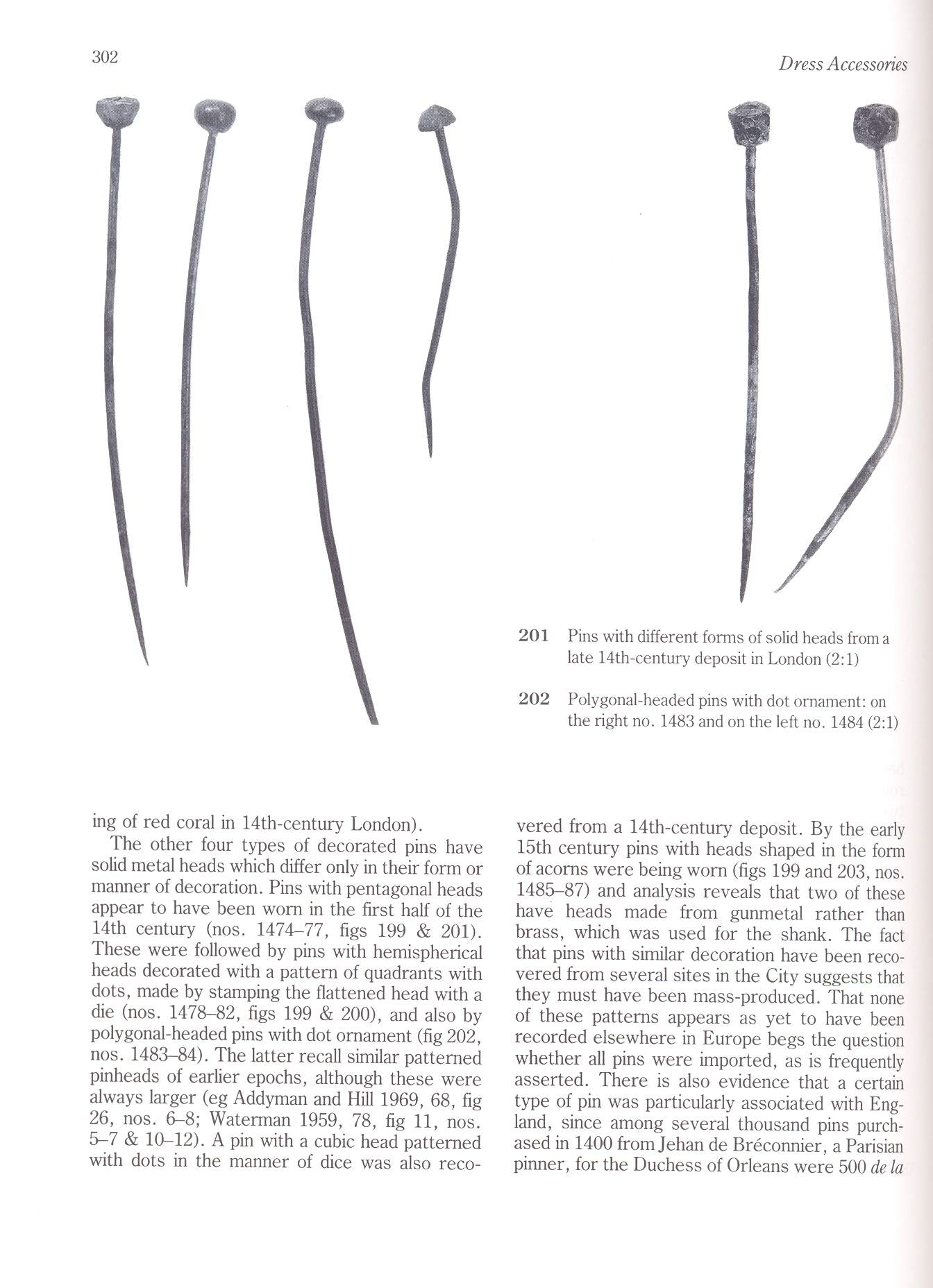329a

302




Dress Accessories

201 Pins with different forms of solid heads from a late 14th-century deposit in London (2:1)
202 Polygonal-headed pins with dot ornament: on the right no. 1483 and on the left no. 1484 (2:1)
ing of red coral in 14th-century London).
The other four types of decorated pins have solid metal heads which differ only in their form or manner of decoration. Pins with pentagonal heads appear to have been wom in the first half of the 14th century (nos. 1474-77, figs 199 & 201). These were followed by pins with hemispherical heads decorated with a pattem of ąuadrants with dots, madę by stamping the flattened head with a die (nos. 1478-82, figs 199 & 200), and also by polygonal-headed pins with dot ornament (fig 202, nos. 1483-84). The latter recall similar pattemed pinheads of earlier epochs, although these were always larger (eg Addyman and Hill 1969, 68, fig 26, nos. 6-8; Waterman 1959, 78, fig 11, nos. 5-7 & 10-12). A pin with a cubic head pattemed with dots in the manner of dice was also reco-vered from a 14th-century deposit. By the early 15th century pins with heads shaped in the form of acoms were being wom (figs 199 and 203, nos. 1485-87) and analysis reveals that two of these have heads madę from gunmetal rather than brass, which was used for the shank. The fact that pins with similar decoration have been reco-vered from several sites in the City suggests that they must have been mass-produced. That nonę of these pattems appears as yet to have been recorded elsewhere in Europę begs the ąuestion whether all pins were imported, as is freąuently asserted. There is also evidence that a certain type of pin was particularly associated with Eng-land, sińce among several thousand pins purch-ased in 1400 from Jehan de Breconnier, a Parisian pinner, for the Duchess of Orleans were 500 de la
Wyszukiwarka
Podobne podstrony:
331 (24) 304Dress Accessories Pins with decorated heads from late 12th, 14th and early 15th-century
367 (17) 340 Dress AccessoriesTin rumbler bells with four petal-like tabs cast in one with loop: A m
318 (36) 290 Dress Accessories one has a tiny spoon at the opposite end from the nib, though MoL acc
425 (10) 398 Dress Accessories surfaces. Many objects had evidence of tin coat-ing (colour pis 4G &a
431 (10) 404 Dress Accessońes —, 1987 ‘Report on the Composition of the Ingots and Axle-Cap’, in Mea
76 Kaushik, I.S. (2010). Effect of herbicide with different modes of action on physiological and cel
skanowanie0066 (3) b) antonymy is a term describing a variety of different forms o
IMGt7 Ernst Mach in favor of a differcnt conccption of that parallclism. From this timc on it was th
- 18 - Hartmann. Sweden ments and areas for eiperimentation with new forms of entrepreneurial thinki
image095 with a specified number of cattle heads, “as if some offerings,” they wouJd be punished “by
Packet Tracer PC Command Linę 1.0 PC>ping 10.0.0.3 Pinging 10.0.0.3 with 32 bytes of data: Reply
274 (42) Dress Accessońes 246 1078 805 1095 (A) mounts with fields of dots (1:1) (
296 (37) 268 Dress Accessońes Brooches with circular frames Leaf 1374 BC72 2037 (83) 11 fig 174 Poss
302 (41) 274 Dress Accessońes buttons of the former kind, found in Lund in Sweden). Composite sheeti
353 (22) 326 Dress Accessories Stirrup-shaped rings with imitation gemstone settings 1608 &nbs
więcej podobnych podstron